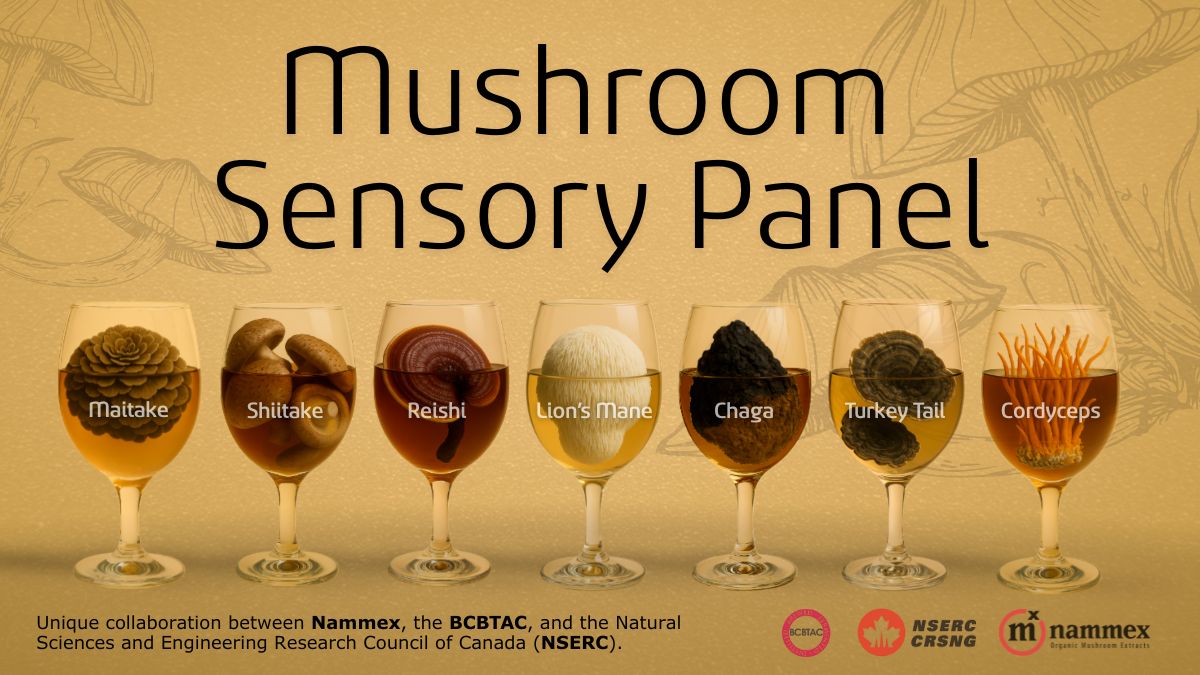What Does Your Mushroom Extract Really Taste Like?
New Sensory Data Could Change Your Formulation Strategy
Download full report summary here
Functional mushrooms commonly seen in capsules and powders, but now more readily enjoying their front row seat in beverages. They’re showing up in everything from cold brew and sparkling tonics to nootropic elixirs and alt-coffee blends. But when it comes to beverage formulation, one detail can make or break a product’s success: taste.
That’s why Nammex commissioned a first-of-its-kind organoleptic mushroom sensory panel—a deep dive into the appearance, aroma, bitterness, and overall flavor characteristics of 16 organic mushroom extracts across 7 species. The results? A goldmine for formulators looking to build functional drinks with real mushroom power—and real consumer appeal.
“Beverage companies are seeing the huge growth in functional drinks designed around the benefits of functional mushrooms, so the purpose of this report is to help them speed their time to market with successful products," said Skye Chilton, Nammex CEO.
Why This Mushroom Sensory Report Matters
For years, mushroom extract choices have been driven primarily by bioactive levels—especially β-glucans. But as the beverage category evolves and consumers take on a more connoisseur-like approach at the shelf, flavor and aroma can no longer be overlooked. Sensory qualities are becoming the foundation of a successful formulation.
This report, titled Elevating Sensory Expectations, was conducted in partnership with the Natural Sciences and Engineering Research Council of Canada (NSERC) and the BC Beverage Technology Access Centre (BCBTAC). It’s designed to help brands:
- Reduce R&D cycles
- Make informed extract selections based on flavor and functionality
- Avoid costly reformulations due to off-notes or haze
- Create a better sensory experience from first sip to finish
Mushroom Extract Tasting Notes with a Purpose
A trained panel—including chefs, a sommelier, and a fermentation expert—evaluated each Nammex extract steeped in hot water (5g in 250mL, steeped 10 minutes), using a 10-point scale for appearance, aroma, bitterness, astringency, acidity, flavor, and overall appeal.
Some key highlights from the findings:
Cordyceps 1:1
A star performer for culinary applications. Panelists called it "rich, delicious, complex," with umami depth and "excellent richness and complexity.” Think: miso, root veggies, and beef marrow—ideal for savory-forward beverages or broth-based innovations
Lion’s Mane 8:1 Dual
Intense flavor and roasted depth (think grilled vegetables and consommé), but higher bitterness. Great for brands aiming for complex profiles with a culinary edge.
Reishi 16:1
Rated highest in bitterness—an impressive 10/10. Strong flavors (burnt cabbage, ginseng, dark tea) but extremely polarizing. Best used carefully, or balanced in blends.
Maitake 8:1
“Concentrated like Maggi,” said one reviewer. Rich in umami with long-lasting flavor, this extract could anchor a savory drink or enhance plant-based soups and broths.
Chaga 8:1
A favorite for coffee alternatives. Deep roasted aromas, cocoa, and licorice tones make it ideal for “black coffee”-style formulations. Described as "really pleasant and warming. Rich and sooo complex!"
What Beverage Developers Should Consider
- Bitterness isn’t always bad—but too much will tank your overall flavor score. It’s about finding the right balance.
- Lower-ratio extracts (1:1) often filter more clearly, making them better suited for RTD beverages. While they contain both soluble and insoluble fiber, they also deliver a nutritional advantage, since most consumers fall short on daily fiber intake.
- Mushroom species and extraction methods matter. A Lion’s Mane 1:1 tastes nothing like a Lion’s Mane 8:1 Dual. Choose wisely.
- Higher-ratio extracts (like 8:1 or 16:1) deliver more concentrated flavors, which can intensify bitterness, umami, or roasted notes. The sensory panel showed these profiles can be powerful and sometimes polarizing. Use them strategically, either as a hero note or balanced within blends.
Free Report for Formulators
Nammex is making the full sensory panel summary available to formulation professionals. If you’re building the next best-selling mushroom beverage—or just want to avoid a bitter R&D mistake—this is a resource worth sipping on.

